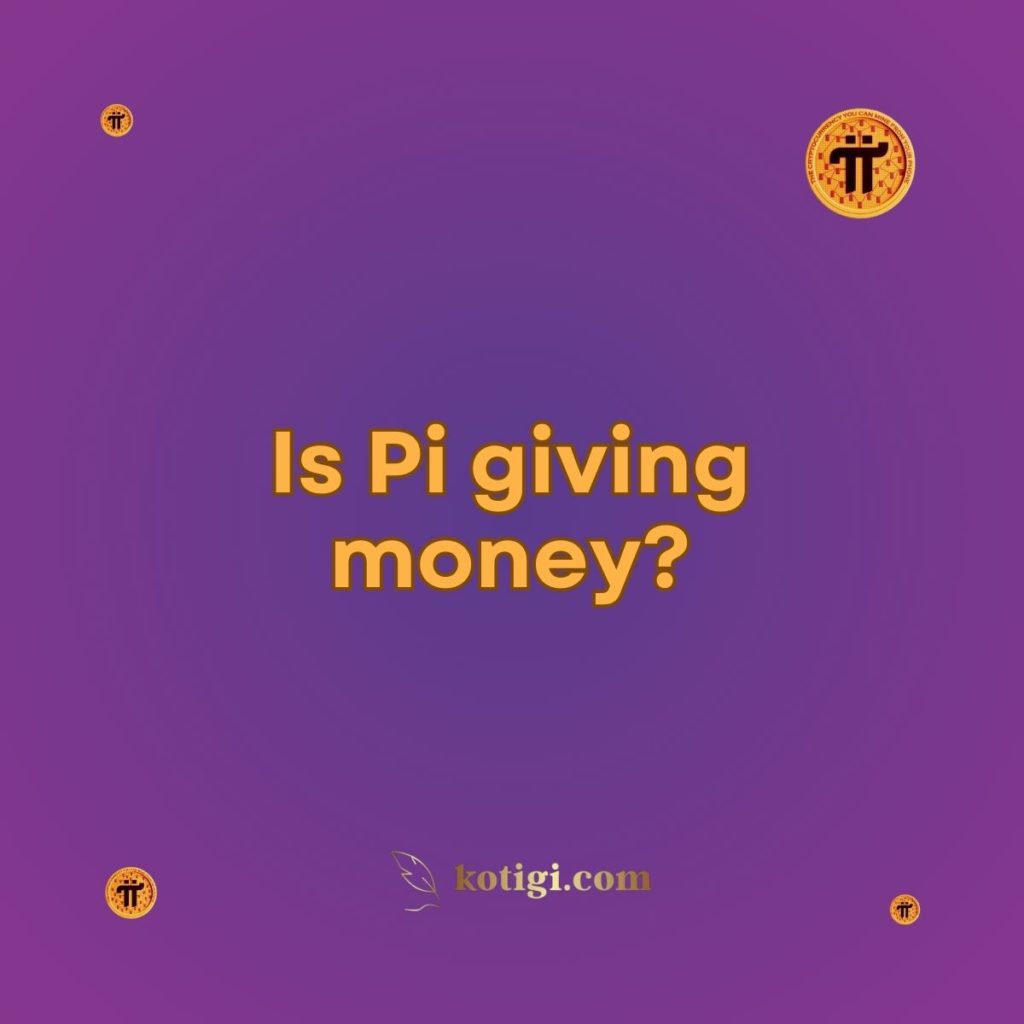
Is Pi giving money?
No, Pi Network does not directly give out money. It allows users to mine Pi coins through a mobile app, but these coins currently hold no monetary value on public exchanges. Pi’s value will depend on future developments, such as transitioning to the open mainnet and listing on cryptocurrency exchanges, where it could then be exchanged for fiat money or other cryptocurrencies.
Introduction
Pi Network has captured the attention of millions of users worldwide by offering a unique approach to cryptocurrency mining—through a mobile app. Many new users, however, wonder if Pi is actually giving out money or how they can convert their mined Pi coins into real-world currency. This article will explore what Pi Network offers, how users can earn Pi, and whether Pi can be considered a source of money.
What Does Pi Network Offer?
Mining Pi on a Mobile Device
Pi Network provides users with the opportunity to mine Pi coins on their smartphones. Unlike traditional cryptocurrencies like Bitcoin, which require specialized hardware and significant energy consumption, Pi mining is done through a mobile app, making it accessible to a wider range of users. By tapping a button once a day, users can mine Pi without draining their phone’s battery or data.
Pi Network’s aim is to build a decentralized cryptocurrency that can be mined efficiently by anyone. Users mine Pi by contributing to the security and maintenance of the network, but at this stage, the coins they mine hold no tangible value on public exchanges.
Earning Pi Coins
Pi Network operates on a referral-based system, encouraging users to invite others to join the network. By growing the network, early adopters increase their mining rate, allowing them to accumulate more Pi coins over time. Users can also form mining teams or “security circles” to further enhance their mining efficiency.
While users can mine Pi coins easily and steadily, the question of whether Pi gives money depends on whether these coins can be converted into a currency with real-world value.
Is Pi Real Money?
Current Value of Pi
At the moment, Pi coins do not have any official monetary value because they are not yet listed on public cryptocurrency exchanges. Pi Network is currently in its enclosed mainnet phase, meaning the mined coins cannot be traded for fiat currency (like USD, EUR, or GBP) or other cryptocurrencies like Bitcoin or Ethereum.
This means that, while users are accumulating Pi coins, they cannot yet convert these coins into real money. Pi’s value is speculative at this stage, and its future worth will depend on several factors, including its adoption, the success of the network’s open mainnet launch, and market demand.
Enclosed vs. Open Mainnet
Pi’s development follows a phased approach, and the network is currently in its enclosed mainnet phase. During this period, users can mine Pi and use it within the network’s ecosystem for peer-to-peer transactions, but they cannot trade it outside the network.
Once Pi transitions to the open mainnet phase, the coins are expected to become tradable on public exchanges, where users could potentially exchange Pi for fiat currency or other cryptocurrencies. However, the timeline for this transition has not been officially confirmed by the Pi Core Team.
How Pi Network Plans to Create Value?
Building an Internal Economy
Although Pi coins cannot currently be sold for money, Pi Network is working on building an internal economy where Pi can be exchanged for goods and services within the ecosystem. Users can participate in peer-to-peer (P2P) transactions using Pi to buy digital products, freelance services, or even physical goods offered by other members of the Pi community.
While this internal economy is still in its infancy, it demonstrates that Pi has the potential to serve as a medium of exchange within its own ecosystem, even if it is not yet tied to a fiat currency.
Future Market Listing
Pi’s ultimate value will depend on its listing on cryptocurrency exchanges during the open mainnet phase. Once listed, Pi coins could be traded like other cryptocurrencies, and their value will be determined by market forces—supply and demand. If Pi attracts significant demand, its value could rise, allowing users to sell their coins for real money.
However, it’s essential to keep in mind that the value of Pi could fluctuate significantly. Like other cryptocurrencies, Pi’s price will be subject to market volatility, and there is no guarantee that Pi will achieve a high or stable value.
Can You Make Money with Pi?
Mining Pi for Future Value
While Pi does not currently offer a direct way to make money, users are essentially mining Pi coins in the hope that they will gain value in the future. As with any speculative investment, there is a risk that Pi’s value may not increase or could even become negligible.
However, if Pi’s open mainnet launch is successful and it gains traction as a widely used cryptocurrency, early adopters could potentially benefit from the coins they mined during the early stages of the network.
Potential Earnings in the Future
Once Pi becomes tradable on exchanges, users may have the opportunity to make money by selling their Pi coins. However, this will depend on the price Pi reaches once it hits the market. Early adopters could potentially sell their Pi for a profit if the demand is strong, but the value of Pi could also remain low or fluctuate greatly, depending on market conditions.
Additionally, as more users join the network, the mining rate will decrease, meaning that those who started mining Pi early may have a larger share of Pi coins compared to later adopters. This could potentially give early users an advantage when Pi becomes tradable.
What Are the Current Uses of Pi?
Peer-to-Peer Transactions
Even though Pi cannot be converted to fiat currency right now, it can be used for transactions within the Pi Network. Users can exchange Pi coins for goods and services in the Pi marketplace, which operates on a peer-to-peer (P2P) model. This means that individuals or businesses within the network can offer products or services in exchange for Pi.
Examples of products and services that users are currently offering for Pi include:
- Digital goods such as software, e-books, or online courses.
- Freelance services including graphic design, web development, or marketing assistance.
- Physical goods such as clothing, electronics, or household items.
While the marketplace is still growing, it offers a way for users to utilize their Pi coins without having to wait for the open mainnet phase.
Supporting Pi’s Ecosystem
Users can also participate in growing Pi’s ecosystem by contributing to Pi-based projects or developing decentralized applications (dApps) that run on Pi’s blockchain. These contributions may help drive the long-term value of Pi, as a strong ecosystem will likely be crucial to its success and adoption.
While participating in the ecosystem does not directly generate money, it could help enhance the value of Pi in the future by increasing its utility and adoption.
Risks and Considerations
Speculative Nature of Pi
It’s important to recognize that Pi is still a speculative project. While it has amassed a large user base and has outlined ambitious goals, its future success is far from guaranteed. As with any cryptocurrency, Pi’s value will depend on its adoption, technological development, and market conditions.
There is a possibility that Pi may not achieve widespread adoption or that its value may remain low even after it becomes tradable. Users who are mining Pi should be aware that they are participating in a speculative venture, and there is no guarantee of financial return.
Regulation and Compliance
Cryptocurrencies are subject to evolving regulations, and Pi Network will need to navigate these regulatory challenges as it moves toward its open mainnet. Governments around the world are still developing policies related to digital currencies, and Pi’s success could be impacted by future regulatory restrictions.
For instance, regulatory hurdles could delay Pi’s listing on exchanges or limit its use in certain jurisdictions. Users should be aware that these factors could affect Pi’s long-term viability and value.
The Future of Pi Network
Roadmap to the Open Mainnet
Pi Network’s long-term plan includes launching its open mainnet, listing Pi on public exchanges, and expanding its internal economy. The transition to the open mainnet will be a critical milestone, as it will determine whether Pi can achieve a tangible monetary value.
Once the open mainnet launches, users will likely have more opportunities to use Pi in various ways, including selling it for money on exchanges or using it as a medium of exchange in a wider array of transactions.
Potential Use Cases for Pi
If Pi successfully launches on exchanges, its potential use cases could expand beyond the current internal ecosystem. Pi could be used as a form of payment in e-commerce, integrated into decentralized finance (DeFi) platforms, or used for cross-border transactions with low fees.
However, these use cases will depend on Pi’s adoption and the development of its ecosystem. For Pi to succeed, it will need to establish partnerships with businesses, developers, and other stakeholders in the cryptocurrency space.
Conclusion
Pi Network is not currently giving out money, as Pi coins cannot yet be traded on public exchanges or converted into fiat currency. However, users can mine Pi and accumulate coins in anticipation of future value, especially if Pi successfully transitions to the open mainnet phase.
For now, Pi can be used within the network’s internal economy for peer-to-peer transactions and goods or services. The future of Pi’s value and its ability to generate money will depend on its adoption, technological advancements, and market demand once it becomes tradable.
While Pi offers an innovative approach to mobile mining, users should be mindful of the speculative nature of the project and the potential risks involved.
Key Takeaways:
- Pi Network is not currently giving out money, as Pi coins cannot be traded for fiat currency yet.
- Pi is still in its enclosed mainnet phase, with future plans to become tradable on public exchanges.
- Users can mine Pi through a mobile app and use it within the Pi ecosystem for peer-to-peer transactions.
- Pi’s future value is speculative and depends on its adoption, open mainnet launch, and market demand.
- Pi Network is a long-term project with potential, but users should be aware of the risks and uncertainties involved.





